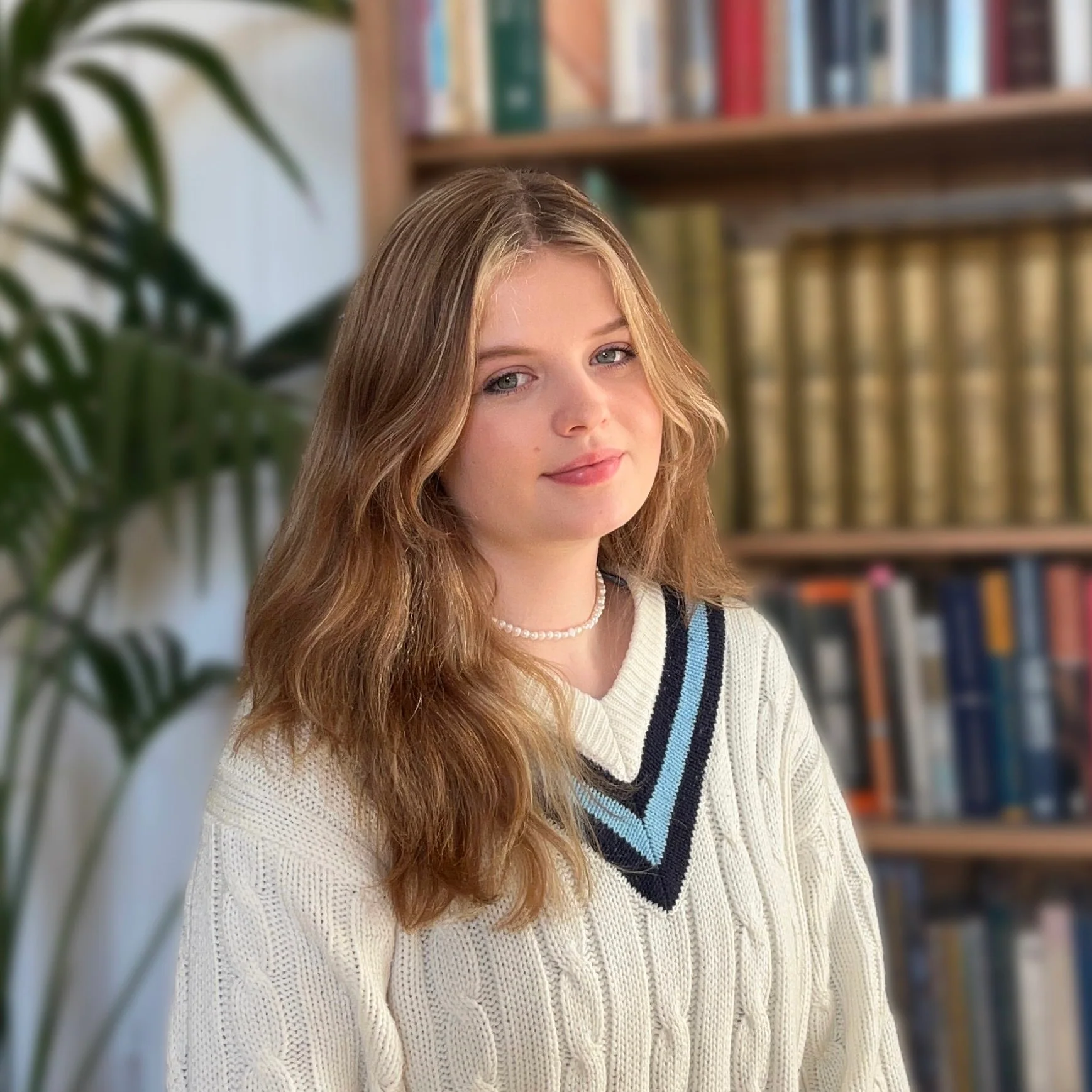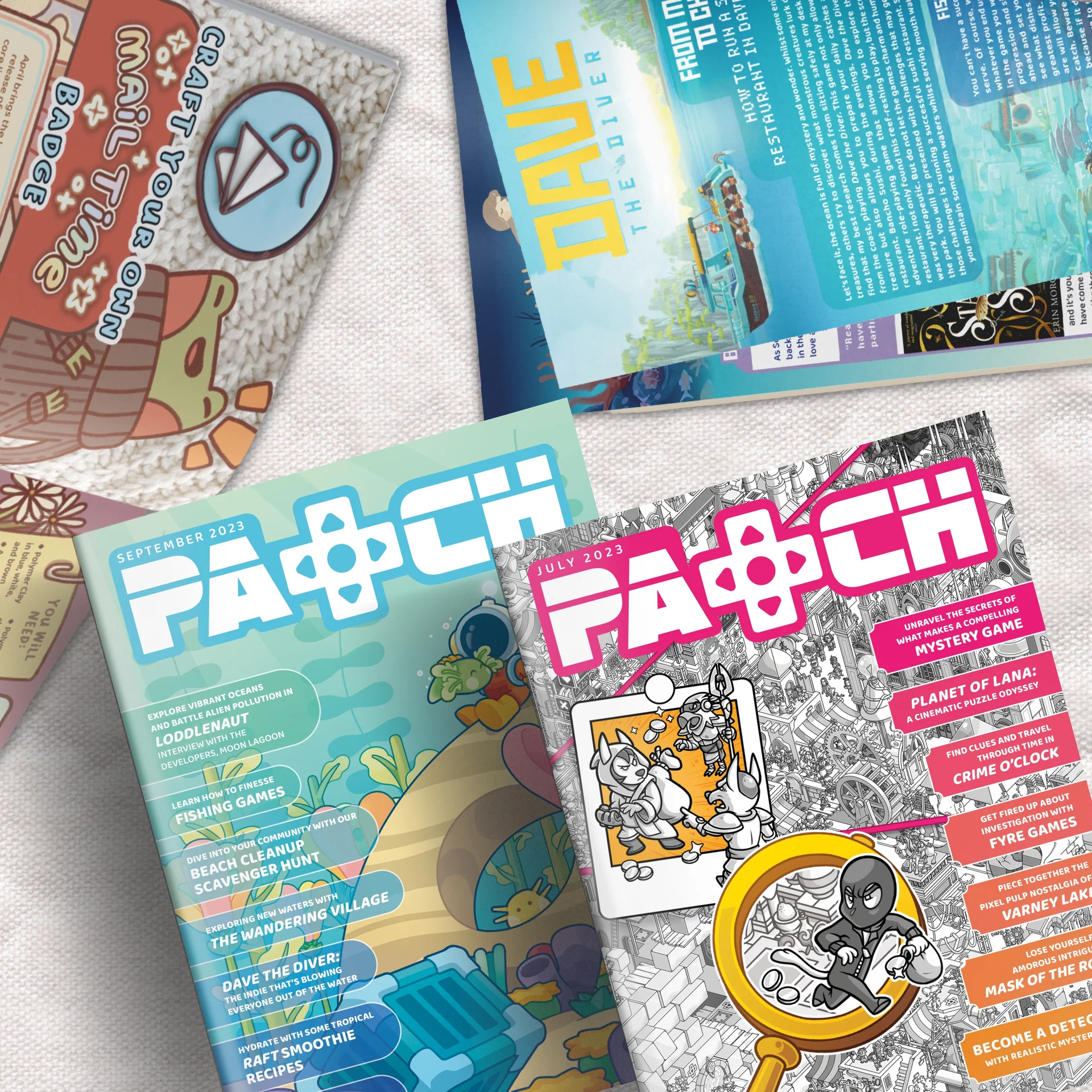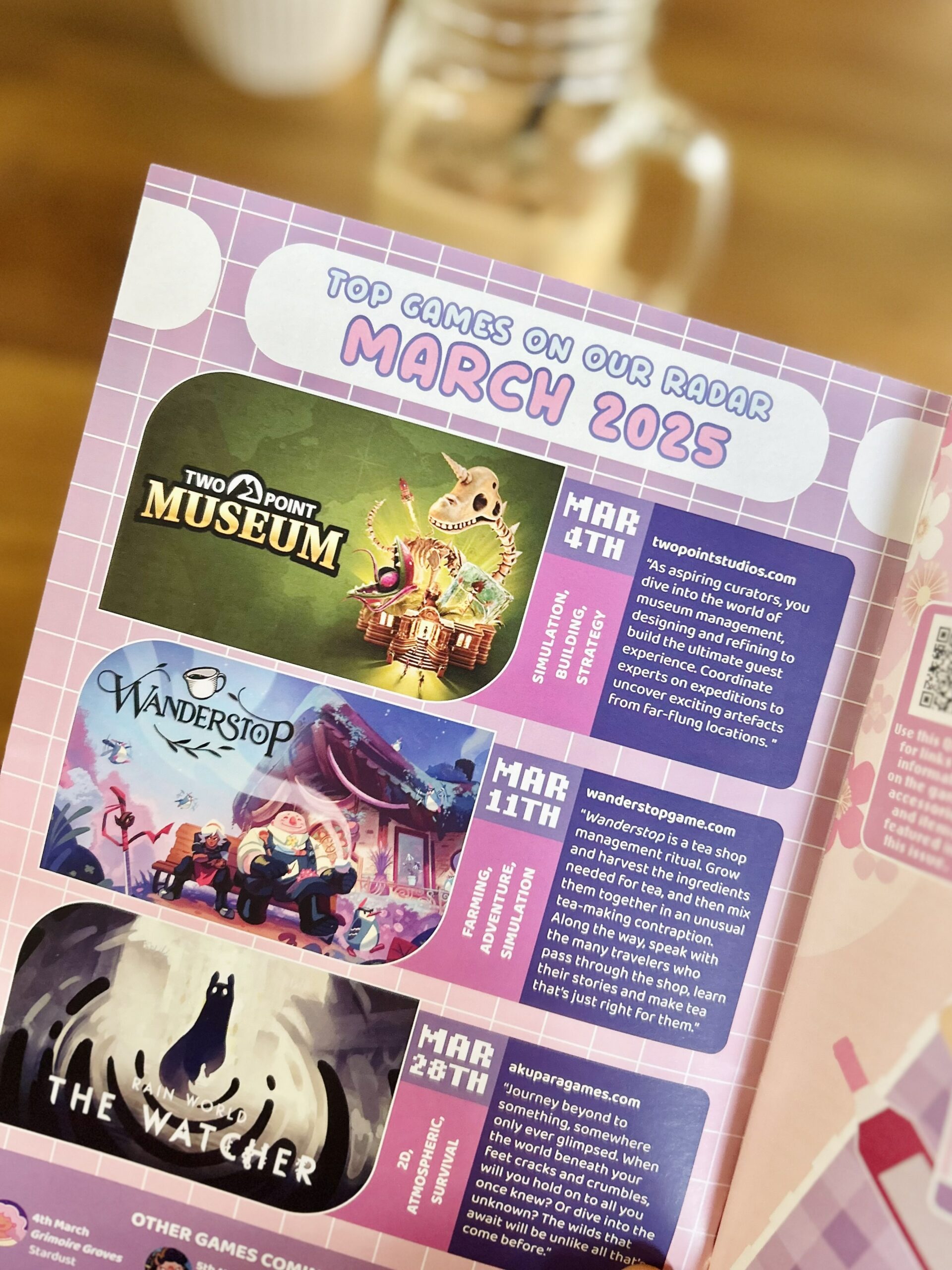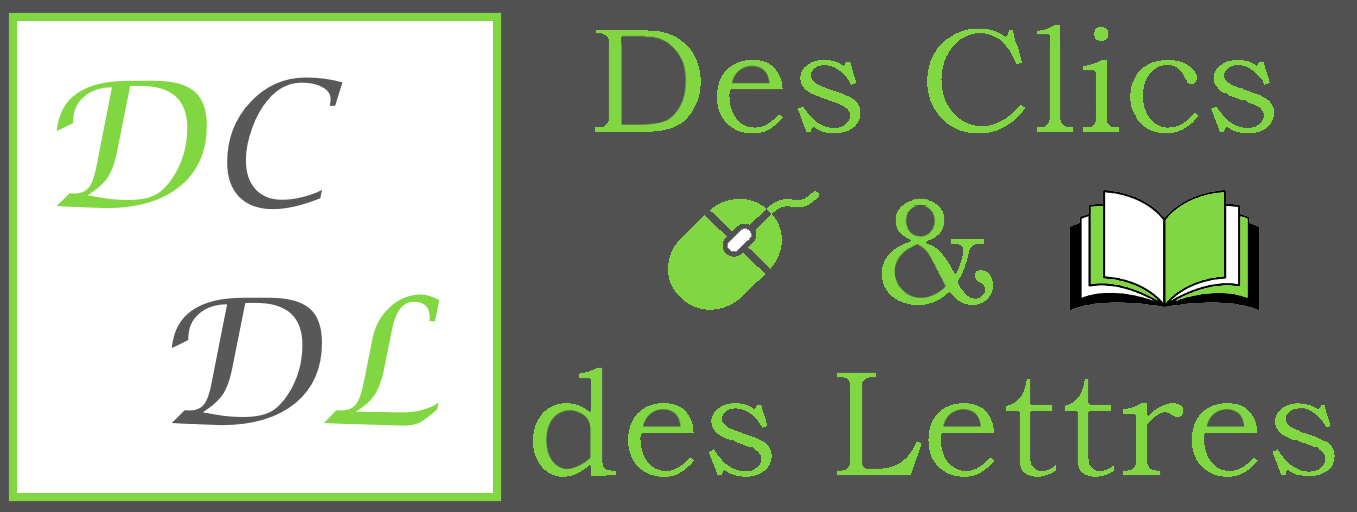Interview done on March 16th 2025
In this new interview on DCDL, Jemima, founder and editor-in-chief of Patch (see website), a thirty-page-long high-quality monthly British magazine about indie gaming, tells us about this publication made with love by passionate writers and illustrators and shares with us her vision of video games as an art form.
INTERVIEW EN FRANÇAIS DISPONIBLE ICI

Hello Jemima, thank you for agreeing to answer a few questions about the magazine you created. As an indie writer, translator, video-game enthusiast and fervent reader of several French gaming magazines (the few last survivors), I had to order at least one issue when I found out about Patch, was instantly convinced and subscribed right away. First, I’d like you to tell me about the origins of the magazine. When was it created? Was Patch some kind of online indie games fan project that then got more and more professional?
Ah, I’m so glad you didn’t say “I instantly threw it away”, haha! It’s always so reaffirming to hear feedback like this, thank you very much. I always say that the origins of the magazine started when I was eight years old, cutting and glueing my own makeshift zines! Or perhaps with 13 Going On 30, one of my favourite films as a youngster that remains my phone wallpaper to this day. But if we’re being more specific, it all started with a Tweet. Before Patch, most of our team were part of a fanzine that we created out of our adoration for Animal Crossing: New Horizons. Back in 2020, I made a call-out on Twitter one day for folks who might be interested in creating “something special”, and the response was phenomenal! Before long, I was holding a tangible print product that we had created from scratch. The feeling was incredible, and I soon realised that we could truly make something out of this. Fast forward a year or so later, and Patch was born. So, essentially, yes. Patch was a fan project that grew… and hopefully will continue to do so! I couldn’t imagine a better way to spend my days or a better team to work alongside.
In most countries, people spend more and more time looking at screens many hours a day and tend to read less and less. They could use their phones and PCs to read digital versions of books and magazines, but that’s not what we can observe when, for instance, we use public transports. Most of them watch short videos and play very simple games. As a result, the idea of creating a new magazine published on paper can sound like a crazy endeavour. What made you want to launch a paper magazine in the 2020s?
Because I felt we could do it differently. It’s true, print is increasingly competing with its digital counterparts: whether that be e-reading platforms, news apps, or social media. But that doesn’t necessarily mean it can’t be revived. In actuality, I think we all have an innate desire for the tangible. Human beings have been turning pages and smelling the woody deliciousness of parchment for centuries, and that appetite for print has not entirely dissolved at the hands of the small contraptions we hold in our pockets. There is, in fact, a growing desire to detach ourselves from the digital realm and return to the present. We’re seeing physical planners and journaling on the rise, paper-like tablets, and even apps to lock us out of other apps. I’ve been on social media since I was 13 years old and I loathe it. The malicious algorithm, the doom-scrolling, the crippling comparisons… It isn’t a particularly pleasant experience 100% of the time. Gaming is a digital activity that I have a much more of a positive relationship with, but the premise remains the same: we’re lacking the opportunity to step back from the screen and just BE, without a consistent overload of dopamine. Despite this, the fact remains that it’s difficult to pull yourself away from easy-to-consume digital media and pick up something else. With Patch, I hope we are creating something that successfully pulls people away, whilst still being able to immerse ourselves in our favourite hobby. It’s fun, engaging, snappy, and everything the team ourselves would want to see in a magazine. In essence, it’s bringing back our childhood enjoyment of print: it doesn’t take itself too seriously and acknowledges that people just want to read something that makes them feel good. When you step into adulthood, it’s almost as though your only options are The Economist or Country Living. Though I appreciate their qualities (I’ll be the first to admit that when I’m commuting at 8 o’clock in the morning), I would prefer not to read a wall of black and white text, 50 times over! That’s not to say I don’t adore getting lost in a hefty novel, don’t get me wrong, but I feel magazines are something different entirely. In my opinion, it shouldn’t be a long battle to consume their contents, because they’re built upon being an on-the-go form of media. Others might feel differently, and that’s totally okay. There should be an option for every type of reader. But for Patch, we wanted to revert back to a simpler and more joyful time in print media, whilst also adapting to the current climate.

I’ve really just discovered Patch (my third issue has just been shipped!) and I wouldn’t be able to describe the whole philosophy behind it. So I’d like you to explain it to me. I’ll just guide you with a few questions. Why did you choose to focus on indie games exclusively? Most of your contributors seem to rather like wholesome games, story-driven experiences with beautiful art styles. Do you also publish articles about difficult, hardcore-gamer oriented games, as long as they were made by indie devs? Each issue of Patch is short (for a foreign reader like me, it’s just perfect), but it’s a really beautiful object, a piece of art just like the games you write about in it. It’s not the kind of magazine you just throw away after reading. Was that what you wanted to achieve?
I think this ties in slightly with my previous answer! Given the easy-going nature of our magazines, I’m finding we do tend to steer towards easy-going gaming. It’s also a result of the indie gaming landscape, right? The indie scene used to be dominated by retro games led by nostalgia. Nowadays, ‘cosy gaming’ has arguably overtaken that genre by miles, and we’re increasingly seeing the words ‘indie’ and ‘cosy’ hand-in-hand. But that’s not to say that we don’t incorporate hair-tearing roguelikes or tense FPS games. We’re still a diverse team, who all enjoy different genres! I’d like to say that we’re super professional and have a strict template for the types of games that we discuss, but in reality, our writers typically just play what they want to play that month. And, to be honest, I think that’s the best way. Without being too rigid, it comes through that we’re writing because we want to and not because we were told to. That being said, to give us a bit more of a guideline (since there are so many games out there), we generally select a theme each month. For example, April’s edition will be all about ‘travelling the world’!
As for your note about Patch being a piece of art, this is exactly how I feel! Am I allowed to admit that? Firstly, I’m in total adoration of our creative team. Creative Director, Natasha, and Layout Designer, Dana, as well as all of our illustrators, consistently produce something worthy of framing. Absolutely, we want the magazine to be as much of a collectible, as it is a sturdy travel companion. Whether readers want to softly flip through the pages before they gently store it on their shelves, or whether they want to tear into it on the bus, it’s totally their call. But either way, we want it to look beautiful. We want it to be something that you open up and can’t wait to flip to the next page to see what’s to come. There’s also the factor that we’re discussing people’s creations, so we want each spread to embellish the discussion rather than have it feel lifeless. With the visuals, we try to immerse readers in the games they’re reading about, and in turn, hopefully encourage them to play!
How many different countries do you ship copies of Patch to on a regular basis? What are, let’s say, the three top countries, outside of Great Britain, in which you sell the most copies? Do you plan on, maybe, someday publishing Patch in other languages? I’m sure there would be many potential buyers here in France!
Outside of the UK, most of our readership is in the United States. We’re also popular across Europe, including The Netherlands and, yes, France! But we have readers all over the globe. It’s always really cool to see orders from places so far from home, like Japan or Chile. If it’s plausible in the future, I’d absolutely consider translating our magazines.
Let’s talk about your gaming history and tastes, Jemima. What kind of games did you play when you were a kid or a teenager? What do you play now? Only indies or some big bad triple-As too from time to time? What games did you particularly like, say, these past two years?
If we want to go way back, my first ever game was Jump Start: Kindergarten, a computer game in which you follow a bunny called Hopsalot through a series of educational mini-games. You might say I was a PC master as early as 5 years old. But kids’ games aside, my first love was Lego Star Wars on PS2, which I refer to far too often. Then followed a number of PS2 hand-me-downs like The Simpsons Game – not to be confused with The Simpsons: Hit & Run, which apparently walked so GTA could run. I then was granted the gift of a Wii and a pearly white DS Lite, giving me access to gems like Mario Kart, The Sims 2, and best of all, Style Boutique. Of course, like many teens in the late noughties / 2010s, I also more-than-dabbled in online ‘girly’ games (looking at you, GirlsGoGames.com). In my older years, my school made the fatal error of giving its students iPads, which threw me into the arms of Minecraft, Slenderman, and pretty much anything I could do other than focus in class. But I was never really introduced to what people consider ‘real’ gaming (I won’t go on a tangent about that) until I was much older. Without any brothers and being surrounded by femmes who were all fed the same message ‘games are for boys’, it took a while for me to discover a different side to gaming. In my late teens though, I was given an Xbox and of course, my first download was Fortnite… I was terrible. But after trying games like Forza, Sea of Thieves and PUBG, I realised, “wow, this is a whole new world I’ve been missing out on”. Maybe I hadn’t missed out. Maybe it was fate that I had completed school with decent grades before falling down the rabbit hole. But indeed, it was a downhill slope from there. My Switch Lite introduced me to Animal Crossing: New Horizons, and my PC introduced me to Valorant – my two fervent interests for the last five years. That said, I often credit the beginning of Patch to my two favourite indie discoveries: Little Nightmares and Night in the Woods. There it is, a complete history of Jemima’s gaming experience! I hope that wasn’t too boring.

The video-game industry is currently going through a heavy crisis. Triple-As cost too much and are not as appealing as they used to be. As a player, I now play indie games almost exclusively. The stories and gameplays they provide are much richer, less mainstream, and I love feeling a connection between the artist(s) and me through a game. Just like when you read a book and can feel your mind getting linked somehow to the writer’s. Do you think indie games are the future of video games?
Absolutely! It’s similar to music, I suppose. The rawer, less polished stuff hits you harder than anything a multi-million-dollar studio can produce. Although there are countless masterpieces in the AAA scene, no doubt, there’s something uniquely captivating about indies. The less layers a game has to filter through and be moulded by, the more freedom it’s granted in its visuals, mechanics, and storytelling. And now that indie developers are rightly seeing success for such creations, publishers are increasingly taking them seriously – with the growth of independent publishers themselves. No longer are we limited to a small pool of elite players that are dominating the industry. Instead, we’re seeing the art of individuals, who are producing equally – if not more – visually and experientially sensational games. I’m so pleased with the direction the industry has moved in and I hope it continues to do so.
To conclude, what is the future of Patch? Do you plan on making it evolve somehow or will you just try to expand your reader base (which is an ambitious enough goal!)? Do you have other personal / artistic projects in the pipeline?
We do indeed. But you’ll have to wait and see!
Thank you so much, Jemima, for your answers! And long live Patch and paper magazines!
Florian Baude (Des Clics & des Lettres)
